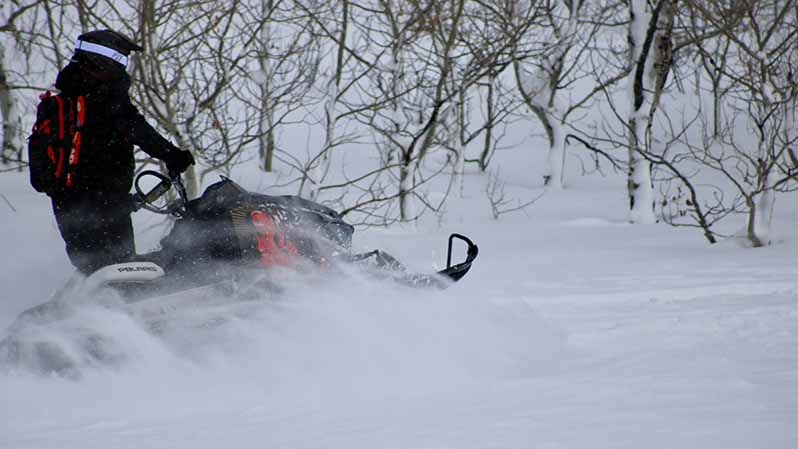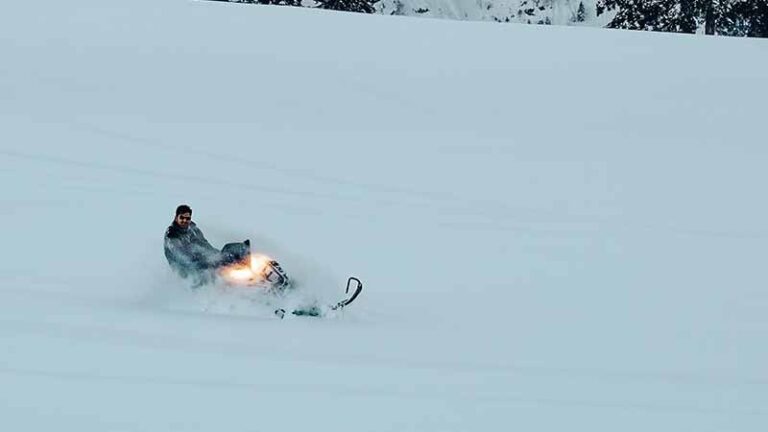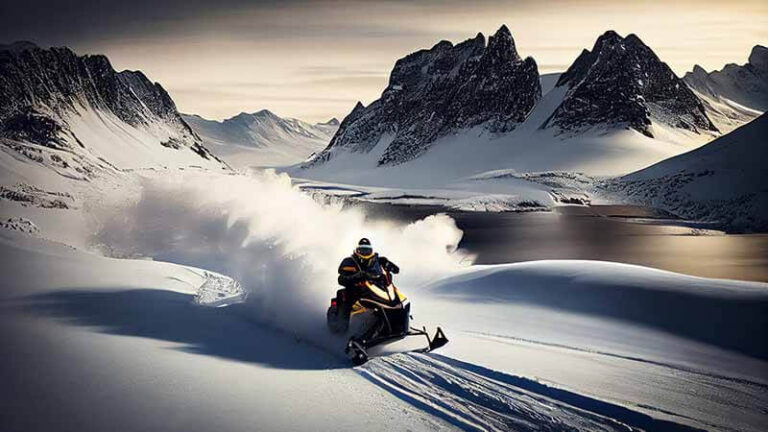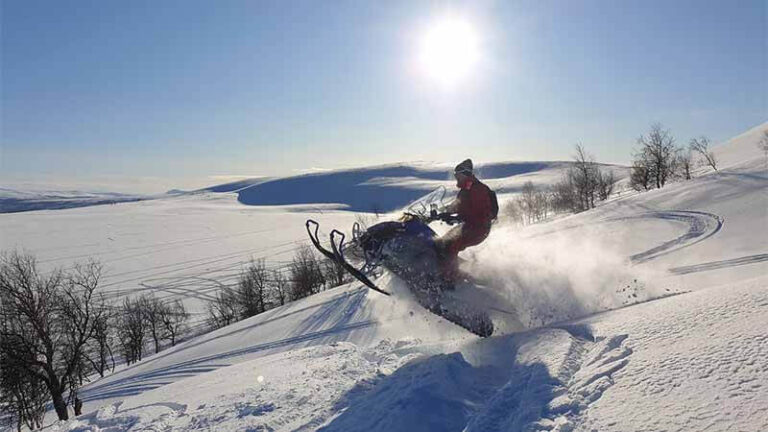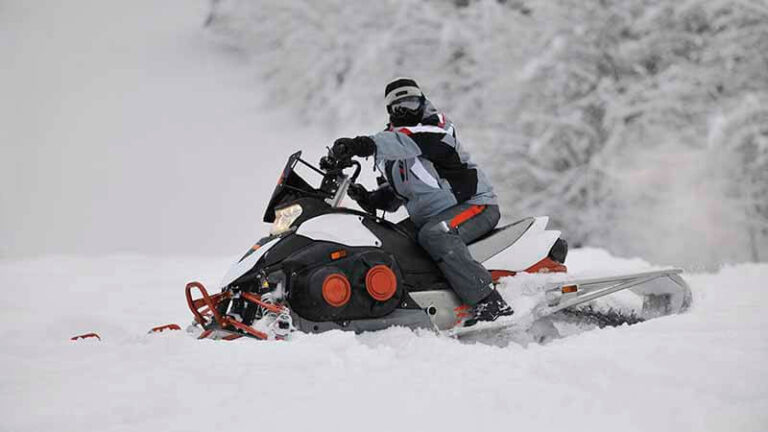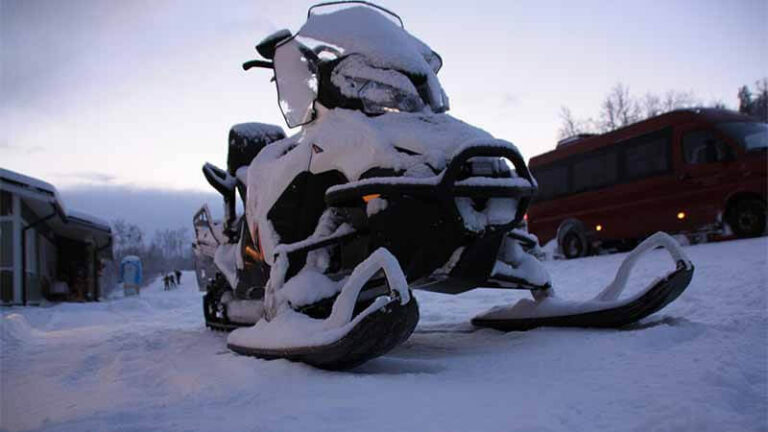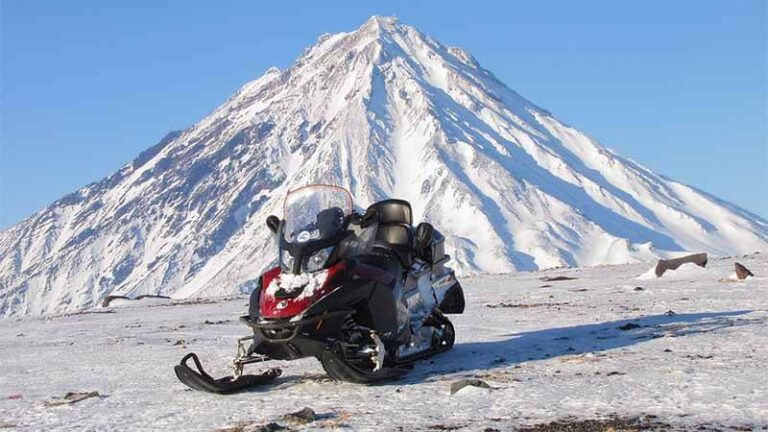How Much Snow Do You Need to Snowmobile
Understanding how much snow is needed for snowmobiling is critical for various reasons. It is first and foremost a question of safety. Snowmobiling in poor snow conditions can be dangerous and increase the likelihood of an accident or injury. Riding on insufficient snow might cause the machine to collide with rocks, stumps, or other impediments, resulting in damage or injuries. Riding in too much snow, on the other hand, increases the risk of becoming stuck or stranded, which can be disastrous.
Knowing the amount of snow needed for snowmobiling is vital for enjoyment as well as safety. Riding a snow machine at a suitable speed in fresh powder may be an exhilarating and pleasurable experience. Trying to ride on too little or too much snow, on the other hand, can be stressful, uncomfortable, and less fun.
Also, understanding the amount of snow required for snowmobiling might assist riders in adhering to regulations and avoiding fines. Many jurisdictions have distinct rules and regulations governing the required minimum snow depth for snowmobiling. Understanding and observing these guidelines can help motorcyclists avoid legal trouble while also contributing to their own and others’ safety.
Factors Affecting the Amount of Snow Needed for Snowmobiling
Terrain type
The type of terrain on which a person is snowmobiling is referred to as terrain type. Flat, open fields, hilly or mountainous terrain, woods, or other sorts of terrain can all be included. Depending on the terrain, the amount of snow required for safe and pleasurable snowmobiling can vary. Riding in deep snow on mountainous terrain, for example, may necessitate more snow than cycling on flat ground.
Snow density
The weight or density of snow on the ground is referred to as snow density. Snow density varies based on elements such as temperature, humidity, and snow age. The amount of snow necessary for safe and fun snowmobiling can be affected by the density of the snow. Lighter, powdery snow, for example, may require greater depth than saturated, heavy snow.
Snowmobile type
The type of snowmobile utilized for snowmobiling is referred to as the snowmobile type. Snowmobiles have varying capacities, and the amount of snow needed for safe and pleasant snowmobiling varies based on the type of snowmobile. A high-performance snowmobile meant for deep powder riding, for example, may require more snow than a lightweight touring snowmobile.
Rider weight and skill level
The amount of snow required for safe and fun snowmobiling is also affected by rider weight and skill level. Heavier riders may need deeper snow to sustain the weight of the snowmobile and rider, but more proficient riders may be able to ride safely on shallower snow.
Temperature and weather conditions
Temperature and weather conditions can also have an effect on how much snow is needed for safe and pleasurable snowmobiling. Warm weather or rain can melt snow, reducing the quantity of snow needed for safe riding, whereas cold temperatures and heavy snowfall can increase the amount of snow needed for safe and enjoyable riding. Furthermore, meteorological variables such as wind and visibility can have an impact on snowmobiling safety and enjoyment.
Ideal Snow Depth for Snowmobiling
General snow depth recommendations
General snow depth recommendations are standards that describe the minimum snow depth required for safe and fun snowmobiling in various terrain and snow conditions. These guidelines are often based on the average weight of a snowmobile and rider, as well as the hazards of colliding with obstacles or becoming trapped in heavy snow. Snow depth requirements vary based on the source and the exact snowmobile model, but they normally range from 6 to 12 inches.
Snow depth recommendations based on terrain type
Snow depth recommendations depending on terrain type might provide more detailed suggestions based on the type of landscape or terrain being snowmobiled on. Riding on hilly or mountainous terrain, for example, may necessitate more snow depth than riding on level ground, due to the increased chance of colliding with objects or becoming stuck. Snow depth suggestions based on terrain type can also vary depending on the difficulty degree of the terrain, such as steep inclines or dips.
Snow depth recommendations based on snow density
Snow depth recommendations based on snow density take the weight or density of the snow on the ground into account. Lighter, fluffy snow may need more depth to sustain the weight of the snowmobile and rider, whereas wet, heavy snow may need less. Snow depth recommendations based on snow density may differ depending on the type of snowmobile and rider weight.
Snow depth recommendations based on snowmobile type
Snow depth recommendations for different types of snowmobiles can provide more specific parameters based on the type of snowmobile being used. Snowmobile models vary in their capabilities and may require varying amounts of snow depth to run safely and enjoyably. A high-performance snowmobile meant for deep powder riding, for example, may need more snow depth than a lightweight touring snowmobile. Snow depth guidelines based on snowmobile type might also vary depending on rider weight and other features of the snowmobile, such as track length or suspension system.
Safety Precautions for Snowmobiling in Different Snow Conditions
Precautions for shallow snow
Being mindful of potential impediments such as pebbles or stumps buried beneath the snow, riding at slower speeds, and avoiding rapid turns or abrupt stops are all precautions for shallow snow. It is also critical to be conscious of the snow’s state, as shallow snow is more prone to melting or hardening, making it more difficult to ride securely.
Precautions for deep snow
Deep snow precautions include being mindful of the possibility of becoming trapped, which is more likely in deeper snow and carrying suitable tools such as a shovel or tow line. Maintaining momentum is particularly vital when riding in deep snow, as stopping or slowing down too much can make it more difficult to get rolling again. Also, it is critical to be mindful of the snow’s quality, as deep snow might be more prone to avalanches and other hazards.
Precautions for icy or hard-packed snow
Precautions for icy or hard-packed snow include being mindful of reduced traction and increased maneuverability in these conditions. It is critical to bike at moderate speeds and avoids unexpected bends or stops. Cyclists should also be cautious of potential hazards such as ice patches or hard-packed snow that may make navigation more challenging.
Precautions for wet or heavy snow
Wet or heavy snow precautions include being aware of the increased weight and difficulty of maneuvering in these conditions. Riders should slow down and prepare for slower acceleration and greater effort necessary to turn or halt. Wet or heavy snow is also more prone to melting or freezing, so riders must be mindful of changing conditions and alter their riding style accordingly. Also, motorcyclists should be cautious of potential risks such as sloppy or unstable snow, which may make safe navigation more difficult.
Tips for Measuring Snow Depth
Tools for measuring snow depth
Snow depth gauges, snow probes, and avalanche transceivers are all tools for measuring snow depth. Snow depth gauges are specifically intended for measuring snow depth and can provide accurate results to the closest inch or centimeter. Snow probes are long, thin rods that are used to measure the depth of snow. Avalanche transceivers are primarily used for safety, but they can also be used to assess snow depth.
Techniques for accurate snow depth measurement
Accurate snow depth measurement techniques involve taking the measurement on level ground, away from any potential barriers that may alter the reading. It is also necessary to take measurements in numerous areas to obtain an accurate average, as snow depth can vary greatly even within a short region. To avoid crushing the snow, snow probes should be centered vertically and gently, whereas snow depth gauges should be held perpendicular to the ground and inserted until they reach the ground surface.
Importance of measuring snow depth before snowmobiling
Assessing snow depth before snowmobiling is essential for a number of reasons. First and foremost, it is critical for riding safety, as insufficient snow depth increases the danger of accidents or becoming stranded in deep snow. Monitoring snow depth can also help riders identify acceptable snowmobiling routes or regions, as well as prevent harm to the snowmobile or the environment.
Furthermore, assessing snow depth can assist riders in planning for the equipment and gear required for safe and pleasurable snowmobiling, such as snowshoes or avalanche beacons. Overall, evaluating snow depth is an important step in preparing for a safe and enjoyable snowmobiling adventure.
Conclusion
It is critical to follow snow depth requirements and safety precautions to ensure a safe and pleasurable snowmobile session. While it may be tempting to push the limits and ride in hazardous conditions, doing so puts riders at risk of accidents, becoming stranded, or encountering other hazards. Riders can reduce these hazards and enjoy snowmobiling in a safe and responsible manner by following snow depth standards and taking necessary safety procedures.
Snowmobiling is a fun and exciting hobby that riders of all ability levels may enjoy. Yet, it is critical to remember that safety should always come first. Riders may guarantee that they are enjoying snowmobiling responsibly and sustainably by adhering to snow depth standards, adopting necessary safety procedures, and being environmentally conscious. So go out and enjoy the snow, but remember to do it wisely and safely!
Read More,

